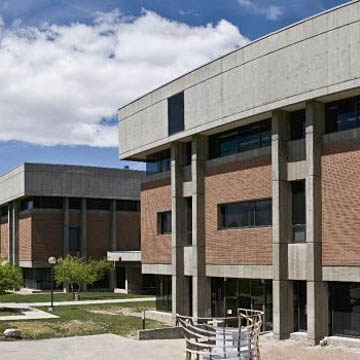The Fine Arts and Architecture Building at the University of Utah was built in 1970 by the distinguished Salt Lake firm Edwards and Daniels Associates. As an educational building dedicated (partly) to the training of future architects, the structure acts as a skillful teacher and an active participant in the pedagogic process. Though inspired by the heroic ideals of modern architecture in the 1920s, it also reflects the changed realities of architecture in the 1960s. Edwards and Daniels, like many of their contemporaries, rejected an earlier aspiration towards impersonal expression; in the Fine Arts and Architecture building, the personal signature of the architect returns with a vengeance.
Gone are thin membranes for walls and floating horizontal and vertical planes that modernists had hoped would free architecture and its inhabitants from the shackles of traditional thinking. Gone is the vast, uninterrupted “universal” space able to accommodate every modern function and, by extension, free occupants from traditional social hierarchies. By the late 1960s, the crystalline box that had found its most beautiful execution in the Illinois Institute of Technology’s School of Architecture in Chicago (1950–1956) had lost its rhetorical force, to be replaced (for a time) by the sculptural power of reinforced concrete.
Though Edwards and Daniels would eventually come under the influence of postmodernism, so evident in their Giovale Library at Westminster College (1997), here, the firm is extending the language of late modernism. The building abounds in references to twentieth-century architectural devices used by Le Corbusier, Alvar Aalto, Paul Rudolph, and Louis Kahn. Most prominent among these is its transformation of Adolf Loos’s Raumplan (plan of volumes) from domestic scale into institutional space. The architects begin with the simplest rectangles in plan, stacked one on top of another. Working sectionally, they accommodate the plan to its sloping site, so that the building itself seems like an intelligent modification of that landscape. They open diagonal views through the sequences of circulation, constantly changing the viewpoint up and down their subtly differentiated levels, much like Paul Rudolph’s Art and Architecture Building at Yale University (1963).
They script the movement through the space without a system of focal points, cross axes, and climaxes as in classical design. Architecture becomes for them the art of composition of solid and void, light and dark, plane and volume. The struggle for elegant neutral containers is replaced by playful differentiation of functions. Each cell in the plan offers a unique pedagogic space. The power of the building lies in its ability to prevent differentiated spaces to collapse into hierarchical spaces. Differentiation is not a register of social privilege, but of variety. This variety is evident even in the handling of circulation: inside, the most efficient of circulation devices, the corridor, sometimes dissolves into platforms, at other times into studio spaces. It sometimes transforms into vertical shoots, and other times into lobbies. Here it takes the guise of skywalks, there it juts out to become an exterior walkway. There are robust walls rising directly from ground, directional piers pulled to the exterior, coffered slabs, projecting roofs, and inverted overhangs. One finds an exaggerated insistence on materiality, weight, heaviness, tactility of masses—in short, on groundedness.
Dramatic textural differences, natural colors, joints, and turns make for rich experiences throughout the building, beginning with the contrast between the concrete structure and the brick infill panels. The structural elements are spanned with red brick, each individuated with precise grouting. Concrete is not smoothed and painted white, but left with the brute marks of framework. Rather than smoothing over joints and transitions, attention is drawn to them. Variety, soundproofing, and a warm touch is achieved by unfinished cedar finishing in places. All other colors and materials are subservient to the gray, red, and clove brown of these three primary materials.
The design of the Fine Arts and Architecture Building was part of the widespread interest in monumentality in form and materials that emerged in the 1960s. Brutalism like this was not uncommon in academic architecture of the period, especially in new “visual arts” buildings jointly housing art and architecture departments. This trend in the 1960s and 1970s points to the widespread public faith in institutions of higher education and the alignment of architectural values with academic values. There is no oppositional stance vis-à-vis the elitism of architecture as a discipline, and its uncritical alliance with the market place. This is an architecture of affirmation and belonging. Freed from its historic burden, architecture has become the art of dynamic volumes, playful spaces, and relationship to site.

